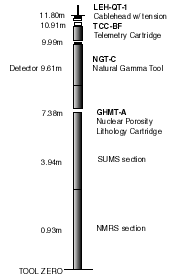Geological High-Resolution Magnetic Tool (GHMT*)
Description
Geological High-Resolution Magnetic Tool (GHMT) provided magnetic susceptibility and total magnetic induction measurements. The
main use of the GHMT was to provide a magnetic reversal sequence in sediment.
in sediment.
The GHMT consisted of two sondes. The Susceptibility Measurement Sonde (SUMS) made an induction-type measurement to record a signal related to formation susceptibility. Its depth of investigation and vertical resolution were about 80 cm and 40 cm, respectively. The Nuclear Resonance Magnetometer Sonde (NMRS) was a high-precision nuclear magnetic resonance device,which accurately measured the total magnetic induction in the borehole. Its depth of investigation was theoretically infinite (most of the Earth’s field is generated in the Earth’s core) and its vertical resolution was about 45 cm.
The GHMT was deployed in forty three holes in the Ocean Drilling Program. It was discontinued after Leg 198.
Applications
Magnetostratigraphy. In order to obtain a magnetic reversal sequence, the total induction and the susceptibility were processed and combined to reveal the polarity of the remanned tmagnetization in the sediment. Normal polarity is in the direction of the presentEarth’s magnetic field; reverse polarity is in the opposite direction. The magnetic reversal sequence can be correlated to the geomagnetic polarity time scale (GPTS) for absolute formation dating, giving a formation depth-to-age conversion and sedimentation rates.
Paleoclimate. Magnetic susceptibility is often a good indicator of climatically induced lithological changes. It has been used in studies of sediment cyclicity, and usually represents
either varying terrestrial sediment input, or varying dilution by, for example, carbonate.
Core-log correlation. Magnetic susceptibility measurements on both core and log were reliable and often displayed correlatable peaks, troughs, and trends. Thus it iwas a good parameter to use for correlation between core and log.
Environmental Effects
The method worked best when the sediment’s remanent magnetizationis strong. The working range of the NMRS was from 27,100 to 69,400 nTesla. The magnetic field in some areas off South America is below this range. When the Earth’s field inclination is + or – 35 degrees (approximately + or – 20 degrees of latitude), the susceptibility effect is zero and the polarity cannot be determined.
Log Presentation
Magnetostratigraphy was compiled from the susceptibility and total induction measurements, and was usually plotted to show the correlation or anticorrelation between the susceptibility and the remanence effects.
Tool Specifications
| Temperature rating: | 260° F (127° C) |
| Pressure rating: | 25 psi (172.3 MPa) |
| Tool diameter: | 3.5 in (8.9 cm) |
| Tool length: | 7.03 ft (2.14 m) |
| Weight: | 286 lb |
| Range full scale: | NMRS from 27100 to 69400 nT |
| Sampling interval: | 2 in (5.08 cm) and 6 in (15 cm) |
Measurement Specifications
| Vertical resolution: | NMRS 17.5 in (45 cm); SUMS 13.5 in (35 cm) |
| Accuracy: | NMRS 0.1 nT; SUMS 0.000005 |
Major Outputs
| MAGB: |
Earth’s Magnetic Field (nT)
|
| MAGS: | Magnetic Susceptibility (ppm SI) |
| MAGC: | Earth’s Conductivity (ppm SI) |
| RMGS: | Low Resolution Susceptibility (ppm SI) |
Deployment Notes
Before ODP Leg 189, the GHMT was deployed in combination with the gamma ray tool (NGT). Starting with Leg 189 it became combinable with the sonic tool (DSI).
* ®trademark of Schlumberger

